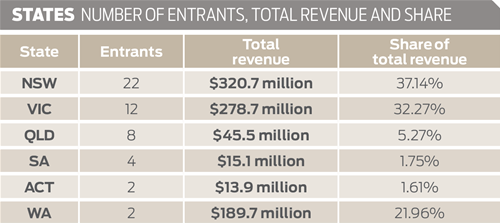This year’s CRN Fast50 turned over a combined $863.6 million in revenue, considerably higher than last year’s group and the second highest revenue in the awards’ history. The companies this year grew sales a staggering total of $304.1 million, year on year.
The average growth rate was up on last year, too. This year’s CRN Fast50 grew at a blistering 75.87 percent average. This year’s No.1, The Missing Link Security, grew faster than last year’s winner. Likewise, this year’s No.50, BigAir Group, was faster than the 50th in 2015. The lowest growth rate to secure a place in the 2016 CRN Fast50 was 27.28 percent, a new record.
What was particularly impressive about this supersonic growth is that in 2016, for the first time, entry to the competition required a minimum revenue of $2 million. That’s a million dollars more than last year, and a big step up from the early days of the competition, when companies only required annual revenue of $250,000 to qualify.
Make no mistake, this year’s batch are major players in the Australian economy, employing around 4500 staff combined and doing serious business in the IT sector.
As always, there was a diverse mix of company ages, sizes and specialities across the list. Sydney is widely accepted as Australia’s tech epicenter, yet last year New South Wales was beaten by Victoria in terms of the state with the most CRN Fast50 companies. NSW is back on top this year, fielding 22 businesses. This was followed by Victoria with 12, Queensland with eight, South Australia with four and the ACT and Western Australian on two apiece.
The No.1 crown also returns to Sydney after five years. The last NSW-headquartered company to take the top spot in the CRN Fast50 was Anittel, which achieved its growth through a concerted acquisition strategy. This year’s No.1, The Missing Link Security, achieved pole position through almost opposite means, established in 2013 as a standalone company by a pair of former Dimension Data executives in partnership with directors from well-known Sydney IT provider, The Missing Link Network Integration.
Victorian companies placed a close second, both in terms of entrants and revenue. Victorian revenue was $278.7 million, versus $320.7 million from NSW. Big Melbourne contributors were publicly listed RXP Services (No.20), which is headquartered in Melbourne and turned over $127.1 million, as well as $38.2 million Revolution IT (No.44) and former No.1 NGage Technology Group (No.10), which turned over $27.7 million.
Despite only fielding two companies this year, Western Australia was a huge contributor thanks to the largest company this year, $179.8 million-turnover Kinetic IT (No.26). As the firm with the highest revenue in the CRN Fast50, Kinetic IT wins this year’s Leader Award.
To be eligible for the CRN Fast50, a company needs to have operated for more than two years. While there were a couple of youngsters – Warehouse1 (No.11) and Strut Digital (No.21) – some 20 of the companies have been in business for a decade. The oldest is Sydney-based Nortec IT (No.34), which returns to the CRN Fast50 after last appearing back in 2012.
More than 200 companies have now appeared in the CRN Fast50 over the eight years of the competition. As always, this year was a mix of first-timers and repeat performers – in fact, the list was split neatly down the middle. As one might expect, the first-timers grew faster but represented a smaller overall percentage of revenue, while the repeat performers didn’t quite grow as fast but represented a bigger slice of the pie.
The Australian IT company with the greatest number of appearances is once again Melbourne-based Blue Apache (No.35), which has secured a ranking in all eight years of the awards, the only company to achieve this feat of consistent performance.
Several other companies in the 2016 CRN Fast50 are part of our All Star club, which recognises businesses to have appeared in the awards at least five times.
Canberra-based Red 29 (No.46) is our newest entrant to this elite group thanks to slow and steady growth over the years. Red 29 first appeared in 2011, when it turned over $1.6 million, and this year it reported revenue of $4.2 million.
This year also marks a return to the list for Commulynx (No.27), which achieved All Star status back in 2014, and now notches up a sixth year in the CRN Fast50.

Revenue mix
Every year, we ask the entrants to the CRN Fast50 to tell us how much revenue came from hardware, software and services. In a U-turn from previous years, the percentage of revenue from services actually decreased in 2016, after what seemed an inexorable move away from product sales. Services represented 56.48 percent of this year’s total turnover, or $487.7 million (last year, services made up more than 70 percent of revenue).
Hardware revenues were worth $223.7 million (25.9 percent) and software generated $152.2 million (17.6 percent). Hardware-led companies grew faster than businesses that were services-dominant, perhaps not surprising given that IT products typically driver higher upfront revenue and hence generate chunkier sales.
In fact, the eight companies that generated the greatest sales from hardware (Warehouse1, Touchpoint Technology, Onel Consulting, BEarena, Correct Communications, NGage Technology Group, EFEX Group and Katana1) were all in the top 20 fastest-growing companies.
On the flipside, of the 10 companies that generated the greatest proportion of revenues from services (Outware Mobile, Bulletproof Group, 4mation Technologies, Best Technology Services, VentraIP Australia, Araza, Strut Digital, RXP Services, Kinetic IT, Neptune Managed Services), only three were within the top 20.
It would be fascinating to see how these companies compared in terms of profitability, however, it is not something we ask entrants to submit, nor something that many would be comfortable sharing.

Next: Product and services







_(21).jpg&h=142&w=230&c=1&s=1)
.jpg&h=142&w=230&c=1&s=1)




.jpg&w=100&c=1&s=0)







.jpg&q=95&h=298&w=480&c=1&s=1)



